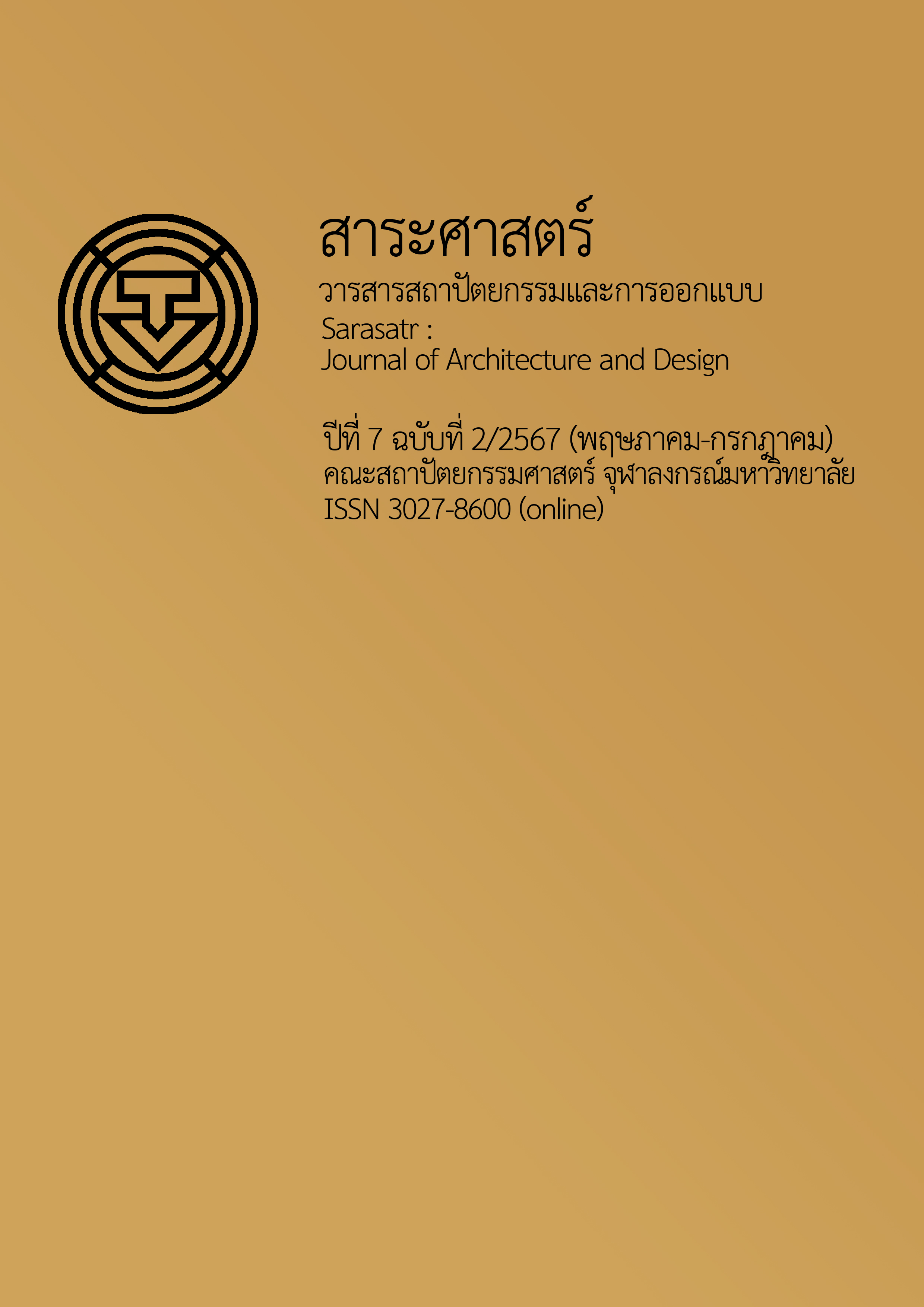The Project Format of Continuing Care Retirement Community (CCRC): Case Studies of Mckean Senior Center and Sawangkanives
Main Article Content
Abstract
Population aging is a global phenomenon because the people born in the baby boom period are becoming elderly. In Thailand, persons 60 years and older account for 18.86 percent of the population, with one in three living independently without a child. The trend of older people living alone is continuously increasing. Consequently, preparation before retirement requires consideration in various aspects, especially housing. The older people often prefer to age in place, but their levels of dependency affect the use of space. The Continuing Care Retirement Community (CCRC) provides continuous support for all levels of dependency. CCRCs are often large-scale, which has an impact on the overall real estate for older people. This research article aims to study the CCRCs project format, analyze space usage behavior, and analyze the problems. To suggest guidelines for developing CCRC projects in the future by surveying and conducting in-depth interviews with older people, entrepreneurs, and caregivers in case studies of two projects: Sawangkanives Housing and Mckean Senior Center.
The study found that having continuous care systems makes older people choose the project because they want to stay in their familiar environment until the end of their lives. This is due to their familiarity with the space, the continuity of care, and the society that takes care of each other. Independent older people will help take care of the assistance or dependent group. But if it's too much, it can lead to neglect of self-care and worsening physical conditions. Therefore, there needs to be a balance in separating groups of older people based on their levels of dependency into separate residence areas and activity areas. In business terms, continuing care retirement community projects are complex to manage in terms of administration and physical environment. That is because the project must support different needs according to levels of dependency. And that is why limitations cause projects to be few when compared to other types of older people real estate projects.
Article Details
References
กฎกระทรวง กำหนดมาตรฐานด้านสถานที่ ความปลอดภัย และการให้บริการในสถานประกอบการเพื่อสุขภาพ ประเภทกิจการการดูแลผู้สูงอายุหรือผู้มีภาวะพึ่งพิงพ.ศ. 2563. (2563). ราชกิจจานุเบกษา. เล่ม 137 ตอนที่ 61ก หน้า 10-15.
กฎกระทรวง กำหนดสิ่งอำนวยความสะดวกในอาคารสำหรับผู้พิการหรือทุพพลภาพ และคนชรา พ.ศ. 2548. (2548). ราชกิจจานุเบกษา. เล่ม 122 ตอนที่ 52ก หน้า 1-13.
กฎกระทรวง กำหนดสิ่งอำนวยความสะดวกในอาคารสำหรับผู้พิการหรือทุพพลภาพ และคนชรา (ฉบับที่ 2) พ.ศ. 2564. (2564). ราชกิจจานุเบกษา. เล่ม 138 ตอนที่ 16ก หน้า 19-29.
กรมกิจการผู้สูงอายุ. (2566). สถานการณ์ผู้สูงอายุไทย พ.ศ. 2565. อมรินทร์.
โกศล จึงเสถียรทรัพย์, พุทธชาติ แผนสมบญ, และธนวรรณ สาระรัมย์. (2560). โครงการการออกแบบสภาพแวดล้อมสถานพยาบาลให้เอื้อต่อการเยียวยา. https://kb.hsri.or.th/dspace/handle/11228/4797?locale-attribute=th
ไตรรัตน์ จารุทัศน์. (2563). 6 รูปแบบธุรกิจอสังหาริมทรัพย์ที่เกี่ยวกับผู้สูงอายุ. https://www.terrabkk.com/articles/105673
ไตรรัตน์ จารุทัศน์. (2565). บ้านปลอดภัย…วัยเกษียณ. สำนักพิมพ์แห่งจุฬาลงกรณ์มหาวิทยาลัย.
ภัสสร์ชญาณ์มน เพรสคอทท์. (2556). สภาพการอยู่อาศัยของผู้สูงอายุภาวะสมองเสื่อมในโครงการที่พักอาศัยสำหรับผู้สูงอายุ [วิทยานิพนธ์ปริญญามหาบัณฑิต, จุฬาลงกรณ์มหาวิทยาลัย]. CUIR. http://cuir.car.chula.ac.th/handle/123456789/43451
สถาบันเวชศาสตร์สมเด็จพระสังฆราชญาณสังวรเพื่อผู้สูงอายุ. (2556). คู่มือมาตรฐานและการดำเนินงานคลินิกผู้สูงอายุคุณภาพ. ชุมนุมสหกรณ์การเกษตรแห่งประเทศไทย.
หน่วยปฏิบัติการวิจัยสภาพแวดล้อมที่เหมาะสมกับผู้สูงอายุและคนพิการ. (2564). บ้านปลอดภัยวัยเกษียณ. https://www.dop.go.th/th/know/15/448
CARF International. (2023). The consumer guide to life plan communities: Quality and financial viability. https://carf.org/wp-content/uploads/2023/06/Consumer-Guide-to-LPCs.pdf
Kastenberg, E. C. & Chasin, J. (2004). IRS elderly housing report. https://www.irs.gov/pub/irs-tege/eotopicg04.pdf
MOH Holdings. (n.d.). Community care apartments. https://www.mohh.com.sg/atlas-care/community-care-apartments
Nastasi, B. K. & Schensul, S. L. (2005, May-June). Contributions of qualitative research to the validity of intervention research. Journal of School Psychology, 43(3), 177-195. https://doi.org/10.1016/j.jsp.2005.04.003
Oak Hammock. (n.d.). Oak Hammock’s history. https://www.oakhammock.org
University of Washington. (2022). What is universal design? https://www.washington.edu/doit/what-universal-design


